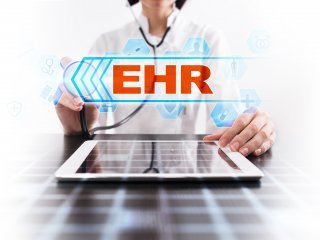
- Description
- Objectives
- Outline
- Materials
- Certification
- System Requirements
- Watch a Demo
The nation's health care delivery system is rapidly being transformed by the introduction of computer-based health information systems - specifically, by electronic health records (EHRs). This Electronic Health Records course answers the need for health care students to understand the entire medical office workflow process, from scheduling an appointment with the doctor to collecting the final payment. Also included in our course is the clinical staff’s use of a point-of-care electronic health record. Included in our course is the detailed use of SimChart’s fully integrated electronic health record and practice management system. SimChart’s simulations allow students to practice each of the medical office workflows steps. Our Electronic Health Records course provides you with techniques and rationales for using electronic health records in practice and shows how the electronic health record affects your responsibilities on the job.
When you begin your career in the health care workplace, it is important that you have a clear understanding of EHR. The knowledge and experience gained through this course will be a vital component of the skills and competencies needed in the 21st century medical workplace.
Prerequisite(s): None
After completing this course, you should be able to:
- Identify the developmental challenges associated with creating electronic health records
- Define electronic health record and its advantages and disadvantages
- Recognize the importance of patient data privacy
- List the steps for basic coding techniques
- Name the steps for documenting in the EHR
Electronic Health Records
Electronic Health Records Module 1
Introduction to the Electronic Health Record
- What is a Health Record?
- Who Documents in the Health Record?
- Who Owns the Health Record?
- The Electronic Health Record
- Advantages of Electronic Health Records
- Disadvantages of Electronic Health Records
- Role of the Healthcare Professional Using the Electronic Health Record
- Professional Organizations
Electronic Health Records Module 2
Overview of SimChart
- The Medical Practice and Electronic Health Records
- Accessing SCMO Through Evolve
- Getting Comfortable with Electronic Health Records
- SCMO Assignment View
- Features in SCMO
- Establishing and Maintaining a Patient Registry
- Internet Use in the Medical Practice
Electronic Health Records Module 3
Privacy, Confidentiality and Security
- HIPAA Law
- Confidentiality vs. Privacy
- Security Safeguards for the Medical Practice
- Patients’ Rights Under HIPAA
- Access to Protected Health Information
- Patients Protecting Health Information
Electronic Health Records Module 4
Administrative Use of the Electronic Health Record
- Role of the Front Office Assistant
- Communication in the Medical Office
- Incident Reports
- Managing Electronic Health Records
- Calendar
Electronic Health Records Module 5
Clinical Use of the Electronic Health Record
- Documentation in the Electronic Health Record
- Clinical Documentation in the Patient Record
- Tracking Health Screenings and Immunizations
- Using the Electronic Health Record for Patient Education
- The Progress Note
Electronic Health Records Module 6
Using the Electronic Health Record for Reimbursement
- Healthcare Reimbursement
- Revenue Cycle
- Coding Systems
- HCPCS
- Pay for Performance
- SuperBill
- Patient Ledger
- HIPAA 5010 Claim Processing
- Medical Necessity
- Fraud and Abuse
- Patient Statements
- Reporting Features of an EHR
Electronic Health Records Module 7
The Personal Health Record and Patient Portals
- What is a Personal Health Record?
- Innovative Features of Personal Health Records
- Benefits to Providers
- Steps in Creating the Personal Health Record
- Maintaining the Personal Health Record
- Patient Portals
**Outlines are subject to change, as courses and materials are updated.**
All course materials included.
Electronic Health Records
Upon successful completion of our Electronic Health Record Specialist course, students will be prepared, in part, to sit for the NHA national certification exam to become a Certified Electronic Health Record Specialist (CEHRS).
Internet Connection
- Broadband or High-Speed - DSL, Cable, and Wireless Connections
*Dial-Up internet connections will result in a diminished online experience. Classroom pages may load slowly and viewing large audio and video files may not be possible.
Hardware Requirements
- Processor - 2GHz Processor or Higher
- Memory - 1 GB RAM Minimum Recommended
PC Software Requirements
- Operating Systems - Windows 7 or higher
- Microsoft Office 2013 or higher. Also, you could use a general Word Processing application to save and open Microsoft Office formats (.doc, .docx, .xls, .xlsx, .ppt, .pptx)
- Internet Browsers - Google Chrome is highly recommended
- Cookies MUST be enabled
- Pop-ups MUST be allowed (Pop-up Blocker disabled)
- The Kindle Reader App or VitalSource Bookshelf App are needed for many of our courses (No special equipment needed. This can be downloaded for FREE onto your computer.)
- PowerPoint Viewer (if you do not have PowerPoint)
- Adobe PDF Reader
- QuickTime, Windows Media Player &/or Real Player
MAC Software Requirements
- Operating Systems - Mac OS x 10 or higher with Windows
- Mac office programs or a Word Processing application to save and open Microsoft Office formats (.doc, .docx, .xls, .xlsx, .ppt, .pptx)
- Internet Browsers- Google Chrome is highly recommended
- Cookies MUST be enabled
- Pop-ups MUST be allowed (Pop-up Blocker disabled)
- The Kindle Reader App or VitalSource Bookshelf App are needed for many of our courses (No special equipment needed. This can be downloaded for FREE onto your computer.)
- PowerPoint Viewer (if you do not have PowerPoint)
- Adobe PDF Reader
- Apple QuickTime Media Player
